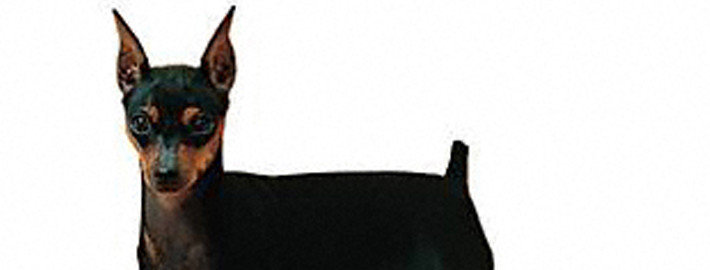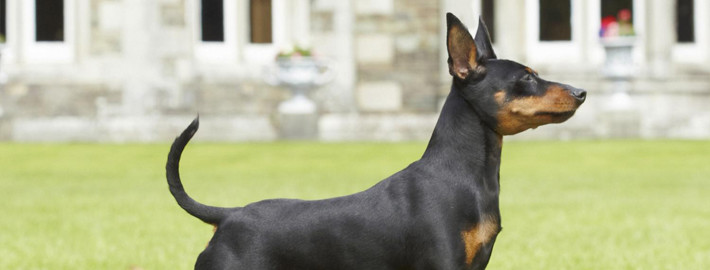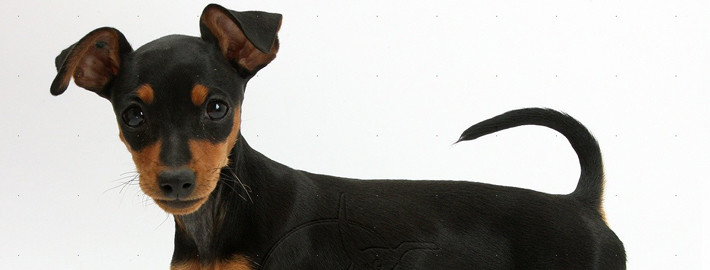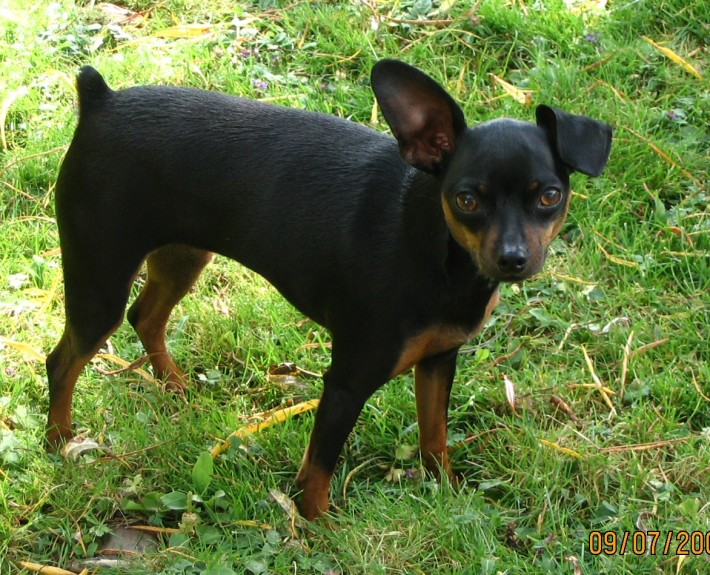What makes the Miniature Pinscher Unique?
Originally from Germany, Miniature Pinschers began their career as vermin hunters, specifically as ratters, but are now more popular as pets for experienced owners. It goes without saying that these small, spunky creatures will certainly enliven any household to which they happen to belong.
Breed Groups
Page Contents
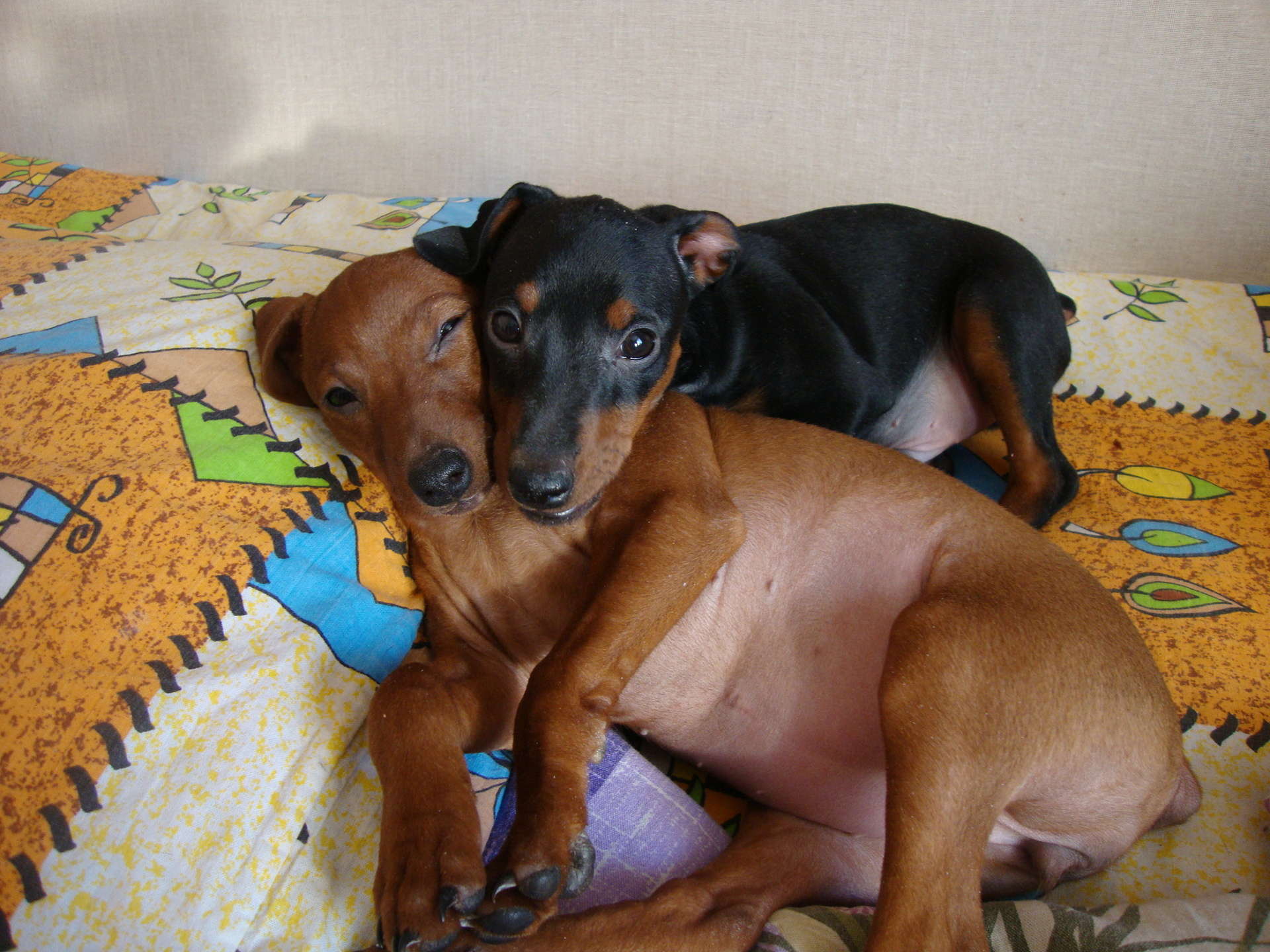
SnapShot
| Size: | Males – 25.4 to 28 cm (10 to 12 inches) Females – 25.4 to 30 cm (10 to 11 inches) |
| Weight: | Males – 3.6 to 4.5 kg (8 to 10 pounds) Females – 3.6 to 4 kg (8 to 9 pounds) |
| Origin: | Germany |
| Life Span: | 14 to 15 years |
| Colour: | Black, Rust, Tan, Chocolate, Red, Stag Red, Blue, Fawn |
| Litter Size: | 1-3 puppies |
Is the Miniature Pinscher Right For You?
Miniature Pinschers are a very active breed. These busy little dogs are also known for their bravely inquisitive dispositions. These dogs can sometimes be either shy or aggressive around strangers and other animals. They have also been known to pick fights with other dogs and chase smaller animals.
Housetraining is typically difficult for this breed and spoiled Miniature Pinschers can be quite unmanageable. Therefore, this breed is not recommended for novice dog owners.
In 5 Words
- Alert
- Docile
- Friendly
- Responsive
- Courgeuos
Characteristics
Learn About the Miniature Pinscher
Description
General Description
Members of this breed have compact, squarely structured bodies. These small dogs also have a level back, high-set ears, and a tapered muzzle. A scissor bite is customary for these canines. Other breed features include darksome dogs there might be some sloping towards the hind end. Miniature Pinschers also possess a tucked up belly, a flat skull, a proportionate, oval-shaped eyes and small, cat-like feet. They move with a high stepping gait. Tails and ears can be cropped in countries where it is permissible to do so, but these features should be left alone in places where the practice is illegal. Members of this breed typically also have their dewclaws removed.
Size
Males of this breed stand between 10 and 12.5 inches tall while their female counterparts are slightly shorter at 10 to 11 inches in height. Miniature Pinschers of both genders typically range from 8 to 11 with the females again being somewhat lighter in weight than the male dogs.
Coat
These dogs have a smooth but short coat that lies close to their bodies. Acceptable coat hues for members of this breed include red, chocolate with tan markings, and black with rust markings. Red dogs may have a plain coat or they may contain black hairs as well in a coloration that is known as ‘stag red’.
Short History of the Pinscher
As is the case with a number of dog breeds, the origins of the Miniature Pinscher are shrouded in mystery but most sources agree that these canines are not a downsized version of a Doberman. In fact, Miniature Pinschers are thought to have originated centuries earlier than their larger contemporaries since they alone show up in artworks dating back to the 1600s.
Possible breeds that may have been included in the Miniature Pinscher bloodline include Italian Greyhounds, Dachshunds, and German Pinschers. It is thought that each of these varieties contributed some of their own characteristics to the Miniature Pinschers. After all, members of this breed are elegant in motion like Greyhounds, courageous in personality like Dachshunds, and active in their pursuits like the German Pinscher. It is further thought that these breed gets their coloration from both Dachshunds and German Pinschers but their build seemingly comes from both the German Pinscher and the Italian Greyhounds. Yet Miniature Pinschers happen to possess certain traits that are uniquely their own.
During the 1800s, the existent specimens were refined to produce the “reh pinscher,” which loosely translates as “red terrier”. These dogs were thought to resemble the red deer of Germany. Eventually, a very tiny version of the breed was produced but they were unsightly to look upon and frail of health. So it is no surprise that by the early 1900s, the problematic trend had been turned around to focus on the breed’s appearance and health.
Miniature Pinschers were commonly seen at dog shows in Germany until the First World War. After that, the breed went into a decline but the dogs that were exported to America and the rest of Europe kept them from becoming extinct. In 1925, the first member of this breed was registered with the American Kennel Club, but in subsequent years there was some confusion as to how the dogs should be classed. However, this was eventually sorted out and Miniature Pinschers are currently considered to be a toy breed.
Temperament
Miniature Pinschers are a very active breed. These busy little dogs are also known for their bravely inquisitive dispositions. These dogs can sometimes be either shy or aggressive around strangers and other animals. They have also been known to pick fights with other dogs and chase smaller animals. Early socialization is an essential step in preventing members of this breed from becoming aggressive. Well-behaved older children are not a problem for these dogs, but Miniature Pinscher will bite if it is roughly handled or teased. Therefore, it is probably not the best pet variety for owners with very young offspring. Miniature Pinschers make wonderful watchdogs. However, these dogs also have a propensity for getting themselves in trouble when left outside for long periods of time. Escapes from the fence are not uncommon. Therefore, they should live indoors with members their human family.
Caring for Your Miniature Pinscher
General Health
Born in litters of 1 to 3 puppies, Miniature Pinschers typically live for about 12 to 15 years. These dogs are nonetheless prone to health problems such as patellar luxation, hypothyroidism, progressive retinal atrophy Legg-Perthes Disease, Mucopolysaccharidosis VI, and heart defects. Regular knee and eye tests can help a dog’s vet spot treatable conditions early so that they don’t become worse.
Owners should also note that Miniature Pinschers do not do well in cold environments and plan accordingly. Members of this breed may additionally eat tiny objects that are left lying around and their areas will need to be kept debris free to prevent them from choking on items like bottle caps. Obesity is another breed health concern. Owners will want to be sure their dogs eat a well-balanced diet and get plenty of exercise to avoid any future difficulties.
Care
Daily
Members of this breed need to be walked every day. Several daily play sessions are likewise recommended. To prevent both tooth decay and bad breath, dogs will need their teeth cleaned regularly. Small dogs are especially prone to dental problems so owners should do so daily but a few times a week is better than nothing at all.
Weekly
It is also a good idea to brush these dogs a few times a week in order to remove dead fur.
Monthly
Parasite prevention medication should be administered to all pets on a monthly basis.
Grooming & Bathing
These dogs can be bathed as often as their owners like or simply when they get dirty. Their toenails should be kept trimmed and their ears kept clean.
Exercise & Training
Although Miniature Pinschers are intelligent, they nonetheless display the stubborn and independent temperaments of most terrier breeds. Housetraining is typically difficult for this breed and spoiled Miniature Pinschers can be quite unmanageable. Therefore, this breed is not recommended for novice dog owners.
It is a good idea for Miniature Pinschers to have a fenced yard to play in. However, these dogs tend to be escape artists and will need a high gate to prevent them from getting out.

